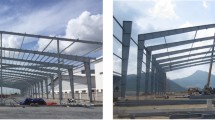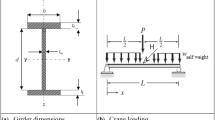Abstract
Half-through girders are not affected by conventional lateral-torsional buckling. I-section beams of simply supported half-through girders experience compression in their top flanges and tension in their bottom flanges. In this condition, the compression flange is restrained only by the stiffness of the web, and the buckling mode is generally restrained distortional. In this study, new and efficient model is derived to predict the Restrained Distortional Buckling (RDB) strength of half-through I-section bridge girders utilizing an Artificial Neural Network (ANN). The model is developed based on a reliable database obtained from the nonlinear finite element (FE) method. To verify the accuracy of the derived model, it is applied to estimate the RDB strength of parts of the FE analysis results that were not included in the modeling process. A sensitivity analysis has been also developed to determine the importance of each input parameters. ANN model is further compared to the some existing design codes. The results indicate that the proposed model is effectively capable of evaluating the RDB load of the half-through girders. The prediction performance of the ANN model is markedly better than prediction of the AISC/LRFD and the AS4100 specifications. The ANN-based design equation can reliably be employed for pre-design applications.
Similar content being viewed by others
References
ABAQUS user’s manual, version 6.9. Pawtucket, RI: Hibbit, Karlsson & Sorenson, 2005.
AISC Specification for structural steel buildings (AISC 360-05) (2005). Chicago (IL): American Institute of Steel Construction.
Alavi, A. H. and Gandomi, A. H. (2009). “Prediction of principal ground-motion parameters using a hybrid method coupling artificial neural networks and simulated annealing.” Computers and Structures, Vol. 89, Nos. 23–24, pp. 2176–94, DOI: 10.1016/j.compstruc.2011.08.019
AS4100 Steel Structures (1998). Standards Australia, Sydney.
Bradford, M. A. (1992). “Lateral distortional buckling of steel I-section members.” Journal of Constructional Steel Research, Vol. 23, pp. 97–116, DOI: 10.1016/0143-974X(92)90038-G
Bradford, M. A. (1997). “Lateral-distortional buckling of continuously restrained columns.” Journal of Constructional Steel Research, Vol. 42, No. 2, pp. 121–39, DOI: 10.1016/S0143-974X(97)00023-0
Bradford, M. A. (1998). “Inelastic buckling of I-beams with continuous elastic tension flange restraint.” Journal of Constructional Steel Research, Vol. 48, Nos. 2–3, pp. 63–77, DOI: 10.1016/S0143-974X(98)90195-X
Bradford, M. A. (2000). “Strength of compact steel beams with partial restraint.” Journal of Constructional Steel Research, Vol. 53, No. 2, pp. 183–200, DOI: 10.1016/S0143-974X(99)00066-8
Bradford, M. A. and Wee, A. (1994). “Analysis of buckling tests on beams on seat supports.” Journal of Constructional Steel Research, Vol. 28, pp. 227–42, DOI: 10.1016/0143-974X(94)90065-5
Fausett, L. (1994). Fundamentals of neural networks, architectures, algorithms, and applications, New Jersey: Prentice-Hall.
Fonseca, E. T., Andrade, S. A. L., and Vellasco, P. C. G. D. (2007). “A parametric analysis of the patch load behaviour using a neuro-fuzzy system.” Journal of Constructional Steel Research, Vol. 63, pp. 194–210, DOI: 10.1016/j.jcsr.2006.04.005
Fonseca, E. T., Vellasco, P. C. G., Andrade, S. A. L., and Vellasco, M. M. B. R. (2003). “Neural network evaluations of steel beam patch load capacity.” Advances in Engineering Software, Vol. 34, Nos. 11–12, pp. 763–72, DOI: 10.1016/S0965-9978(03)00104-2
Fonseca, E. T., Vellasco, P. C. G., Andrade, S. A. L., and Vellasco, M. M. B. R. (2003). “A patch load parametric analysis using neural Networks.” Journal of Constructional Steel Research, Vol. 59, No. 2, pp. 251–67, DOI: 10.1016/S0143-974X(02)00024-X
Garson, G. D. (1991). “Interpreting neural-network connection weights.” AI Expert, Vol. 6, pp. 47–51.
Gholizadeh, S., Pirmoz, A., Attarnejad, R. (2011). “Assessment of load carrying capacity of castellated steel beams by neural networks.” Journal of Constructional Steel Research, Vol. 67, pp. 770–779. DOI: 10.1016/j.jcsr.2011.01.001
Goh, A. T. C., Wong, K. S., and Broms, B. B. (1995). “Multivariate modelling of FEM data using neural networks.” Developments in neural networks and evolutionary computing for civil and structural engineering, Edinburgh, UK: Proceedings of the Civil-Comp Press.
Guzelbey, I. H., Cevikb, A., and Gogus, M. T. (2006). “Prediction of rotation capacity of wide flange beams using neural networks.” Journal of Constructional Steel Research, Vol. 62, pp. 950–61, DOI: 10.1016/j.jcsr.2006.01.003
Hajela, P. and Berke, L. (1992). “Neural networks in structural analysis and design: an overview.” J Comput Syst Eng, Vol. 3, pp. 525–38, DOI: 10.1016/0956-0521(92)90138-9
Hancock, G. J., Bradford, M. A., and Trahair, N. S. (1980). “Web distortion and flexural-torsional buckling.” Journal of the Structural Division, Vol. 106, No. 7, pp. 1557–1571.
Hristev, R. M. (1998). The ANN book, GNU public license.
Jenkins, W. M. (1995). “Neural network-based approximations for structural analysis.” Developments in neural networks and evolutionary computing for civil and structural engineering. Edinburgh, UK: Proceedings of the Civil-Comp Press.
Jixiang, X., Jincheng, Z., Wanzhen, W., and Minglu, L. (2013). “Prediction of temperature of tubular truss under fire using artificial neural networks.” Fire Safety Journal, Vol. 56, pp. 74–80, DOI: 10.1016/j.firesaf.2013.01.006
Kalkan, I. and Buyukkaragoz, A. (2012). “A numerical and analytical study on distortional buckling of doubly-symmetric steel I-beams.” Journal of Constructional Steel Research, Vol. 70, pp. 289–297. DOI: 10.1016/j.jcsr.2011.06.006
Marquardt, D. (1963). “An algorithm for least squares estimation of non-linear parameters.” J Soc Ind Appl Math, Vol. 11, pp. 431–41.
Ok, D., Pu, Y., and Incecik, A. (2006). “Artificial neural networks and their application to assessment of ultimate strength of plates with pitting corrosion.” Ocean Engineering, Vol. 34, pp. 2222–2230, DOI: 10.1016/j.oceaneng.2007.06.007
Pu, Y. and Mesbahi, E. (2006). “Application of artificial neural networks to evaluation of ultimate strength of steel panels.” Engineering Structures, Vol. 28, pp. 1190–1196, DOI: 10.1016/j.engstruct.2005.12.009
Roberts, T. M. and Jhita, P. S. (1983). “Lateral, local and distortional buckling of I-beams.” Thin-Walled Struct, Vol. 1, pp. 289–308, DOI: 10.1016/0263-8231(83)90011-3
Sharifi, Y. (2011). “Reliability of deteriorating steel box-girder bridges under pitting corrosion.” Advanced Steel Construction, Vol. 7, No. 3, pp. 220–238, DOI: 10.18057/IJASC.2011.7.3.2
Sharifi, Y. and Paik, J. K. (2010). “Environmental effects on ultimate strength reliability of corroded steel box girder bridges.” Structural Longevity, Vol. 18, No. 1, pp. 1–20.
Sharifi, Y. and Paik, J. K. (2011). “Ultimate strength reliability analysis of corroded steel-box girder bridges.” Thin-Walled Structures, Vol. 49, No. 1, pp. 157–166, DOI: 10.1016/j.tws.2010.09.001
Sharifi, Y. and Paik, J. K. (2014). “Maintenance and repair scheme for corroded stiffened steel box girder bridges based on ultimate strength reliability and risk assessments.” Engineering Structures and Technologies, Vol. 6, No. 3, pp. 43–53, DOI: 10.3846/2029882X.2014.972991
Sharifi, Y. and Tohidi, S. (2014). “Lateral-torsional buckling capacity assessment of web opening steel girders by artificial neural networks–elastic investigation.” Frontiers of Structural and Civil Engineering, Vol. 8, No. 2, pp. 167–177, DOI: 10.1007/s11709-014-0236-z
Sharifi, Y. and Tohidi, S. (2014). “Ultimate capacity assessment of web plate beams with pitting corrosion subjected to patch loading by artificial neural networks.” Advanced Steel Construction, Vol. 10, No. 3, pp. 325–350, DOI: 10.18057/IJASC.2014.10.3.5
Sheidaii, M. R. and Bahraminejad, R. (2012). “Evaluation of compression member buckling and post-buckling behavior using artificial neural network.” Journal of Constructional Steel Research, Vol. 70, pp. 71–77, DOI: 10.1016/j.jcsr.2011.10.020
Svensson, S. E. (1985). “Lateral buckling of beams analysed as elastically supported columns subject to a varying axial force.” Journal of Constructional Steel Research, Vol. 5, No. 3, pp. 179–193. DOI: 10.1016/0143-974X(85)90002-1
Tohidi, S. and Sharifi, Y. (2014). “Inelastic lateral-torsional buckling capacity of corroded web opening steel beams using artificial neural networks.” The IES Journal Part A:Civil & Structural Engineering, Vol. 8, No. 1, pp. 24–40, DOI: 10.1080/19373260.2014.955139
Tohidi, S. and Sharifi, Y. (2014). “Restrained distortional buckling capacity of half through bridge girders.” The IES Journal Part A:Civil & Structural Engineering, Vol. 7, No. 3, pp. 163–173, DOI: 10.1080/19373260.2014.921400
Tohidi, S. and Sharifi, Y. (2015). “Neural networks for inelastic distortional buckling capacity assessment of steel I-beams.” Thin-Walled Structures, Vol. 94, No. 9, pp. 359–371, DOI: 10.1016/j.tws.2015.04.023
Topping, B. H. V. and Bahreininejad, A. (1995). “Subdomain generation using parallel Q-state potts neural networks.” Developments in neural networks and evolutionary computing for civil and structural engineering. Edinburgh, UK: Proceedings of the CivilComp Press.
Williams, F. W. and Jemah, A. K. (1987). “Buckling curves for elastically supported columns with varying axial force, to predict lateral buckling of beams.” Journal of Constructional Steel Research, Vol. 7, No. 2, pp. 133–47, DOI:10.1016/0143-974X(87)90025-3
Zirakian, T. and Showkati, H. (2007). “Experiments on distortional buckling of I-beams.” Journal of Structural Engineering, Vol. 133, pp. 1009–17, DOI: 10.1061/(ASCE)0733-9445
Çevik, A. (2007). “A new formulation for longitudinally stiffened webs subjected to patch loading.” Journal of Constructional Steel Research, Vol. 63, pp. 1328–40, DOI: 10.1016/j.jcsr.2006.12.004
Author information
Authors and Affiliations
Corresponding author
Rights and permissions
About this article
Cite this article
Tohidi, S., Sharifi, Y. A new predictive model for restrained distortional buckling strength of half-through bridge girders using artificial neural network. KSCE J Civ Eng 20, 1392–1403 (2016). https://doi.org/10.1007/s12205-015-0176-8
Received:
Revised:
Accepted:
Published:
Issue Date:
DOI: https://doi.org/10.1007/s12205-015-0176-8




